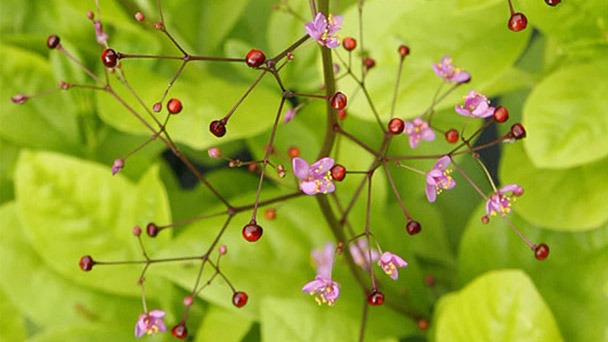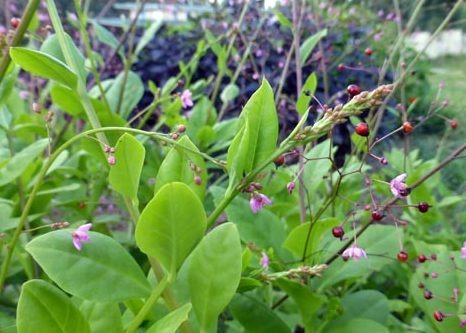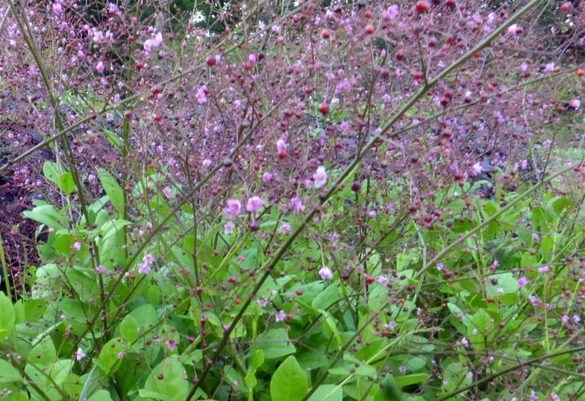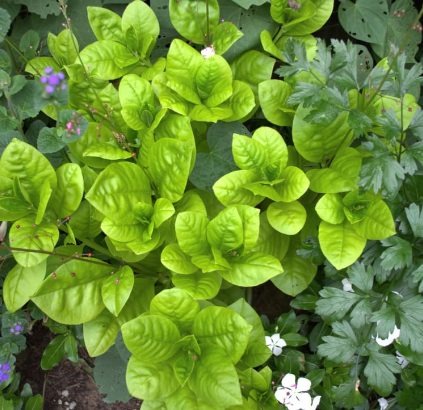Jewels of Opar - Uses & How to Grow
Written by Ivy
Jan 09 2023

Being a succulent, the Jewels of Opar's leaves store water and don't require much watering. This natural succulent flower, also referred to by its scientific name Talinum paniculatum, is called Jewels of Opar and is primarily used for ornamental and edible purposes. It is also referred to as the fame flower and a pink baby flower. Besides at the gate or garden entrance, you can plant this flower along the sides. You cannot adequately describe how good it looks in words. It creates a flower bouquet. Additionally, this plant is quite simple to maintain.
Jewels of Opar Care Tips

Size and Growth
While some talinum species only grow to a height of 1' to 2' feet, talinum paniculatum var bears tuberous roots that resemble ginseng and can grow up to 3' feet tall.
It produces long, thin stems with smooth, succulent green leaves. Light to medium green is a common color for the stems and leaves of succulent plants.
Flowering and Fragrance
The springtime blossoming of Talinum paniculatum 'Limon' results in panicles of flowers. Inflorescences called panicles have many branches.
The plant is known as jewels-of-Opar because of the pink flowers that yield fruits that resemble jewels.
The flowers can come in a variety of colors. Pink and orange-red are typical hues. They don't emit a smell that can be detected.
Light and Temperature
Placed in a sunny window, the plant thrives because it enjoys direct sunlight.
The plant must be kept close to a source of bright, indirect sunlight throughout the entire winter.
The plant produces fewer and duller flowers when there is insufficient light.
Although some people have successfully grown the plant outdoors in colder climates, it can survive outdoor growth in USDA hardiness zones 10 or higher.
Water & Fertilizer
Succulent plants like the Talinum paniculatum don't require as much watering.
But to ensure that your plant survives, water it once a month to twice a month, and allow the soil to completely dry out.
Since it is not in bloom during the winter, it is best to limit watering as little as possible.
Use a quick-release fertilizer with a ratio of 15-15-15 or 10-10-10 when fertilizing talinum paniculatum.
The best times to fertilize your talinum paniculatum are in the early spring or summer, either before or during bloom.
Water your talinum paniculatum thoroughly after fertilizing it.
The talinum paniculatum will, however, flourish even if you neglect to fertilize your plant. The plant is hardy and requires little upkeep.
Soil and Transplanting
Use regular potting soil with some sand added for better drainage when growing Jewels-of-Opar in a pot.
If the soil in your garden tends to dry out too quickly, perlite can help.
As the root system develops, young plants might require transplanting.
Before transplanting the plants, give them time to establish themselves.
Older plants don't need to be transplanted, but they might benefit from having the top layer of soil replaced.
Grooming
After the flowers fade in the summer, prune the plant back if it has a lot of leggy growth.
Transplanting
You should begin clearing space in the garden for these lovely plants now that the seedlings have hardened off. Pick the location carefully.
Preferably choose a location with moderate sun exposure. The full sun is ideal for these plants' growth. It can also develop in different tones. Try to choose a location with a composition of a shiny-shady atmosphere if a sunny space is not readily available. At least it will function properly.
Get the weeds out of the chosen area and well-till it now. You can also mix in some organic composted material, but this plant can also thrive in less-than-ideal soil conditions. You must guarantee that the soil is properly drained. It will assist in avoiding numerous difficulties.
You can now transplant the seedlings because the soil is prepared. Verify that the holes are thoroughly dug to enclose the plant's root ball. Keep the distance between the plants at 12 to 18 inches. After planting, gently press the soil around the plants. Once the plants are planted, add water to them.

How to Propagate Jewels of Opar
Plant cuttings or seeds in sandy soil to begin new growth.
Cut the plants from the stems in the summer after the spring seeding.
Small seeds make up the crop.
- The seeds should be combined with some sand before being scattered over the potting soil to be sown.
- A little more sand should be added after lightly pressing the soil down.
- Never use glass or plastic to enclose the seeds.
- Keep the seedling tray or pots open and close to a window with good lighting.
The plant should bloom in the middle of the summer and grows quickly from seed.
Take cuttings toward the end of the summer if the plant needs to spend the winter indoors.
After the cuttings take root, plant them in sandy soil and place them under a bright light.
The seedlings and cuttings need to be watered frequently until they become established, but excessive watering can result in a number of disease issues.
Between waterings, let the soil get mostly dry. After each watering, drain excess water.
Jewels of Opar Plant Pests and Diseases
Spider mites frequently target drying plants like jewels of Opal. Your succulent shrub might have this problem frequently.
Spray the plant lightly with water and mild soap if you notice a problem. If that doesn't work, you can find a miticide that will solve the problem.
Aphid infestations that affect Jewels of Opar might also call for insecticide.
You can release ladybugs to eat and eradicate the aphid infestation if you plant your jewels of opar in your garden.
Is Jewel of Opar Edible?
First of all, as discussed earlier this plant not only adds ornamental value to the garden or to the indoor settings but also fulfills the edibility purpose also. When it is planted in a garden, it has a longer decorative lifespan until the winter's final frost.
Although it does better in the sun, this plant can still grow in the shade. If grown inside, put it close to the shiny door. Additionally, during the sweltering summers, it serves as a useful source of green leaves for vegetables. It is also tasty and is easily sown from the seeds by saving the flowers.
Additionally, because this plant produces a lot of flowers, bees and other pollinators are drawn to it, aiding in the garden's effective pollination. From the container in which it was sown, you can easily transplant this plant to the garden. Additionally, although not for an extended period of time, this plant is drought tolerant.
These characteristics make it a plant that is easy to maintain and has a lot of advantages. These plants can also reach heights of two to three feet. It is therefore easy to maintain because it does not spread widely. USDA zones seven and above can support the growth of this plant.

Conclusion
When it comes to watering requirements, Jewels-of-opar is not very demanding. In the winter, you can trim any overgrown, sick, or dead branches. Only when the weather is extremely dry will Jewel of Opar grow in full sun and water.
FAQs
Can You Eat Talinum Paniculatum?
Here are a number of dishes that feature jewels of Opar. Its leaves are typically consumed. For salads, sandwiches, and stews, these leaves are used. The fact that these leaves are frequently accessible during the hot summers makes them valuable. The seeds are also a good source of Omega3 oils.
What Are the Benefits of Talinum?
In Asian nations, the jewels of Opar are used for some medical purposes. Overuse of it can make you sick. So, use it as medicine only after seeking appropriate medical advice.
This plant adds real value to the backyard landscape. It not only satisfies all of a gardener's wishes in terms of gardening, but it is also simple to propagate. After you grow it, you'll want to add more of them, and people will ask you for the seeds.
Latest Updated
- Benefits of Bugleweed - 7 Science-backed Health Benefits
- Bugleweed Dangers & Side Effects - Is It Poisonous?
- How to Plant Evergreen Trees - What You Should Know
- When to Plant Evergreens - Grow Guide for Evergreen Trees
- 12 Wonderful Evergreen Shrubs for Your Garden
- 12 Popular Evergreen Plants with Pictures for Beginners
- When And How To Prune A Lilac Bush Like a Pro
- How to Grow & Care for Lilac Vine (Hardenbergia Violacea)
- Japanese Lilac Tree (Syringa Reticulata) Care & Propagation Guide
- Shumard Oak Pros and Cons - What to Know
Popular Articles
- Winter maintenance of Antirrhinum Majus
- How to Grow Terminalia Mantaly Tree
- How to Grow and Care for Crossostephium Chinense
- How to grow Antirrhinum Majus in spring
- Peristeria Elata (Dove Orchid) Profile: Info & Care Guide
- Underwatered Snake Plant (Sansevieria Trifasciata) - Signs And How To Fix
- How to Care for Brazilian Jasmine Plant (Mandevilla Sanderi)
- How to Grow & Care for Graptopetalum Purple Delight in Summer
- Rosa Chinensis (China Rose): Plant Growing & Care Tips
- How to Care for Baby Sun Rose (Aptenia Cordifolia)